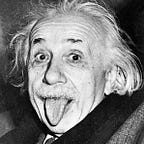Prospect Theory in less than 3 minutes
If prospect theory had a flag, the image above would be drawn on it wrote Daniel Kahneman in his book Thinking Fast and Slow referring to the theory that he and Amos Tversky developed in 1979 and that was many years after awarded the Nobel prize in economics in 2002. Here is my attempt to explain the core concepts of this theory in less 3 minutes.
1. Evaluation is relative to a neutral reference point
We assign gains and losses in terms of outcomes depending on our individual and unique view of those outcomes. Outcomes that are better than the reference point are gains and those that are below are considered losses.
For example, picture a situation in which you get promoted at work with a raise. If your reference point is the salary you had before, you will consider the promotion as a gain because:
Outcome (new salary) > Reference point (own’s previous salary) = GAIN
However, if your reference point is the salary of your colleagues, which is still a bit better than your new raise, you will consider your promotion as a loss because:
Outcome (new salary) < Reference point (colleagues’ salary) = LOSS
2. Diminishing sensitivity
Once we have assigned an outcome as either a gain or a loss, the evaluation of this outcome will depend on its subjective difference.
Following the previous example while looking at the graph above, if you viewed your promotion as a gain in which:
Previous salary = $900 + Raise ($100) = Current salary ($1,000)
you will value your raise more greatly as if:
Previous salary = $3,000 + Raise ($100) = Current salary ($3,100)
Although the raise is exactly the same amount in both scenarios ($100), you will value more positively the first one ($900 + $100) because the subjective difference is much greater than the difference of the second one ($3,000 + $100).
3. Loss aversion
Losses loom larger than gains.
In line with our example and the graph (look at two curves of the S, they are not symmetrical, the slope of the losses changes abruptly at the reference point), imagine that a week after your promotion, your manager tells you that unfortunately there will be temporary pay cuts to those who were just promoted. This pay cut will mean getting your previous salary without the raise ($900). As a consequence, you will feel bad twice as much as when you felt happy for getting the raise (approximately a loss aversion ratio ranging between 1.5 to 2.5) even though the amount you gained and lost is the same ($100).
That’s it! If you understood those 3 concepts, you know what prospect theory is all about. I’ll appreciate any feedback given :). If you’d like to get in touch, here’s my LinkedIn.
REFERENCES
Kahneman, D., Thinking Fast and Slow. Macmillan (2011)
